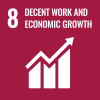Growth in the global economy has picked up in the last six months in line with expectations, but in many regions, growth remains below the levels needed for rapid progress towards achieving the Sustainable Development Goals, according to the United Nations World Economic Situation and Prospects as of mid-2017 report.
The report identifies a tentative recovery in world industrial production, along with reviving global trade, driven primarily by rising import demand from East Asia. World gross product is expected to expand by 2.7 per cent in 2017 and 2.9 per cent in 2018, unchanged from UN forecasts released in January this year. This marks a notable acceleration compared to just 2.3 per cent in 2016.
In a statement on the report, Mr. Lenni Montiel, Assistant Secretary-General for Economic Development in the UN Department of Economic and Social Affairs, underscored the “need to reinvigorate global commitments to international policy coordination to achieve a balanced and sustained revival of global growth, ensuring that no regions are left behind.”
According to the report, underpinning global economic recovery is firmer growth in many developed economies and economies in transition, with East and South Asia remaining the world’s most dynamic regions. However, economic recovery in South America is emerging more slowly than anticipated, and gross domestic product (GDP) per capita is declining or stagnant in several parts of Africa.
Forecasts for GDP growth in some of the least developed countries (LDCs) have been revised downward since January, with growth in the group as a whole projected to remain well below the Sustainable Development Goals target of at least 7 per cent. The report notes that under the current growth trajectory and assuming no decline in income inequality, nearly 35 per cent of the population in LDCs may remain in extreme poverty by 2030. Additional policy efforts are needed to foster an environment that will accelerate medium-term growth and tackle poverty through policies that address inequalities in income and opportunity.
The report points to a combination of short-term policies to support consumption among the most deprived and longer-term policies, such as improving access to healthcare and education and investment in rural infrastructure.
The report states that inflation dynamics in developed economies have reached a turning point, and risks of prolonged deflation have largely dissipated. By contrast, inflationary pressures have eased in many large emerging markets, allowing interest rates to come down.
The report further stresses heightened uncertainty over international policy, which will hinder a strong rebound in private investment globally. Corporate sectors in many emerging economies are vulnerable to sudden changes in financial conditions and destabilizing capital outflows, which could be triggered by faster-than-expected interest rate hikes in the United States.
The report highlights some positive developments related to environmental sustainability. The level of global carbon emissions has stalled for three consecutive years. This reflects growing renewable power generation, improvements in energy efficiency, transition from coal to natural gas, and also slower economic growth in some major emitters. But, the report also warns against waning commitments going forward.
Looking ahead, the report advocates for renewed global commitments to deeper international policy coordination in key areas, including aligning the multilateral trading system with the 2030 Agenda for Sustainable Development; expanding official development aid; supporting climate finance and clean technology transfer; and addressing the challenges posed by large movements of refugees and migrants.
 Welcome to the United Nations
Welcome to the United Nations

